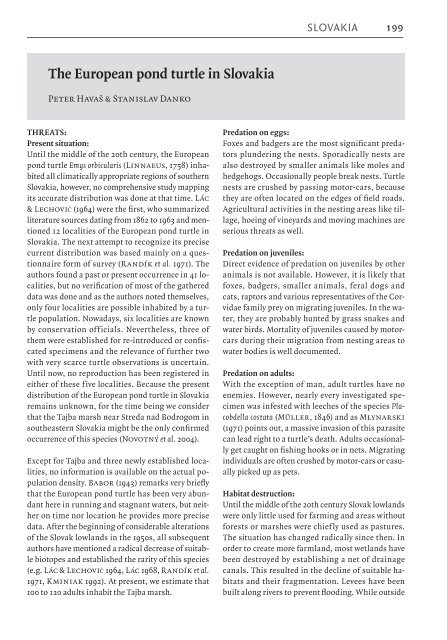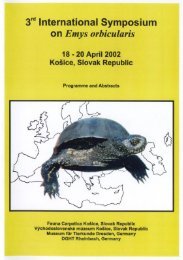The European pond turtle in Slovakia - Fauna Carpatica
The European pond turtle in Slovakia - Fauna Carpatica
The European pond turtle in Slovakia - Fauna Carpatica
Create successful ePaper yourself
Turn your PDF publications into a flip-book with our unique Google optimized e-Paper software.
<strong>Slovakia</strong><br />
199<br />
<strong>The</strong> <strong>European</strong> <strong>pond</strong> <strong>turtle</strong> <strong>in</strong> <strong>Slovakia</strong><br />
Peter Havaš & Stanislav Danko<br />
THREATS:<br />
Present situation:<br />
Until the middle of the 20th century, the <strong>European</strong><br />
<strong>pond</strong> <strong>turtle</strong> Emys orbicularis (L<strong>in</strong>naeus, 1758) <strong>in</strong>habited<br />
all climatically appropriate regions of southern<br />
<strong>Slovakia</strong>, however, no comprehensive study mapp<strong>in</strong>g<br />
its accurate distribution was done at that time. Lác<br />
& Lechovič (1964) were the first, who summarized<br />
literature sources dat<strong>in</strong>g from 1862 to 1963 and mentioned<br />
12 localities of the <strong>European</strong> <strong>pond</strong> <strong>turtle</strong> <strong>in</strong><br />
<strong>Slovakia</strong>. <strong>The</strong> next attempt to recognize its precise<br />
current distribution was based ma<strong>in</strong>ly on a questionnaire<br />
form of survey (Randík et al. 1971). <strong>The</strong><br />
authors found a past or present occurrence <strong>in</strong> 41 localities,<br />
but no verification of most of the gathered<br />
data was done and as the authors noted themselves,<br />
only four localities are possible <strong>in</strong>habited by a <strong>turtle</strong><br />
population. Nowadays, six localities are known<br />
by conservation officials. Nevertheless, three of<br />
them were established for re-<strong>in</strong>troduced or confiscated<br />
specimens and the relevance of further two<br />
with very scarce <strong>turtle</strong> observations is uncerta<strong>in</strong>.<br />
Until now, no reproduction has been registered <strong>in</strong><br />
either of these five localities. Because the present<br />
distribution of the <strong>European</strong> <strong>pond</strong> <strong>turtle</strong> <strong>in</strong> <strong>Slovakia</strong><br />
rema<strong>in</strong>s unknown, for the time be<strong>in</strong>g we consider<br />
that the Tajba marsh near Streda nad Bodrogom <strong>in</strong><br />
southeastern <strong>Slovakia</strong> might be the only confirmed<br />
occurrence of this species (Novotný et al. 2004).<br />
Except for Tajba and three newly established localities,<br />
no <strong>in</strong>formation is available on the actual population<br />
density. Babor (1943) remarks very briefly<br />
that the <strong>European</strong> <strong>pond</strong> <strong>turtle</strong> has been very abundant<br />
here <strong>in</strong> runn<strong>in</strong>g and stagnant waters, but neither<br />
on time nor location he provides more precise<br />
data. After the beg<strong>in</strong>n<strong>in</strong>g of considerable alterations<br />
of the Slovak lowlands <strong>in</strong> the 1950s, all subsequent<br />
authors have mentioned a radical decrease of suitable<br />
biotopes and established the rarity of this species<br />
(e.g. Lác & Lechovič 1964, Lác 1968, Randík et al.<br />
1971, Km<strong>in</strong>iak 1992). At present, we estimate that<br />
100 to 120 adults <strong>in</strong>habit the Tajba marsh.<br />
Predation on eggs:<br />
Foxes and badgers are the most significant predators<br />
plunder<strong>in</strong>g the nests. Sporadically nests are<br />
also destroyed by smaller animals like moles and<br />
hedgehogs. Occasionally people break nests. Turtle<br />
nests are crushed by pass<strong>in</strong>g motor-cars, because<br />
they are often located on the edges of field roads.<br />
Agricultural activities <strong>in</strong> the nest<strong>in</strong>g areas like tillage,<br />
hoe<strong>in</strong>g of v<strong>in</strong>eyards and mov<strong>in</strong>g mach<strong>in</strong>es are<br />
serious threats as well.<br />
Predation on juveniles:<br />
Direct evidence of predation on juveniles by other<br />
animals is not available. However, it is likely that<br />
foxes, badgers, smaller animals, feral dogs and<br />
cats, raptors and various representatives of the Corvidae<br />
family prey on migrat<strong>in</strong>g juveniles. In the water,<br />
they are probably hunted by grass snakes and<br />
water birds. Mortality of juveniles caused by motorcars<br />
dur<strong>in</strong>g their migration from nest<strong>in</strong>g areas to<br />
water bodies is well documented.<br />
Predation on adults:<br />
With the exception of man, adult <strong>turtle</strong>s have no<br />
enemies. However, nearly every <strong>in</strong>vestigated specimen<br />
was <strong>in</strong>fested with leeches of the species Placobdella<br />
costata (Müller, 1846) and as Młynarski<br />
(1971) po<strong>in</strong>ts out, a massive <strong>in</strong>vasion of this parasite<br />
can lead right to a <strong>turtle</strong>’s death. Adults occasionally<br />
get caught on fish<strong>in</strong>g hooks or <strong>in</strong> nets. Migrat<strong>in</strong>g<br />
<strong>in</strong>dividuals are often crushed by motor-cars or casually<br />
picked up as pets.<br />
Habitat destruction:<br />
Until the middle of the 20th century Slovak lowlands<br />
were only little used for farm<strong>in</strong>g and areas without<br />
forests or marshes were chief ly used as pastures.<br />
<strong>The</strong> situation has changed radically s<strong>in</strong>ce then. In<br />
order to create more farmland, most wetlands have<br />
been destroyed by establish<strong>in</strong>g a net of dra<strong>in</strong>age<br />
canals. This resulted <strong>in</strong> the decl<strong>in</strong>e of suitable habitats<br />
and their fragmentation. Levees have been<br />
built along rivers to prevent flood<strong>in</strong>g. While outside
200<br />
<strong>Slovakia</strong><br />
of these levees wetland areas have started suffer<strong>in</strong>g<br />
from the lack of water and have <strong>in</strong>evitably dried up,<br />
floods and raised water levels <strong>in</strong>side of the levees often<br />
have destroyed appropriate places for egg deposition.<br />
Important egg-lay<strong>in</strong>g sites have completely<br />
disappeared after the construction of dams.<br />
Human consumption:<br />
At present, we are not aware of any consumption of<br />
the <strong>European</strong> <strong>pond</strong> <strong>turtle</strong> by man. However, there<br />
is a reliable report that at least until 1945, <strong>turtle</strong>s<br />
used to be caught <strong>in</strong> the vic<strong>in</strong>ity of the village Streda<br />
nad Bodrogom, held <strong>in</strong> butts and subsequently<br />
prepared as food for feasts <strong>in</strong> the manor of baron<br />
Véczey (Randík et al. 1971). Accord<strong>in</strong>g to Voskár<br />
(1989) this was carried on even <strong>in</strong> the 1960s.<br />
Collect<strong>in</strong>g for trade:<br />
No <strong>in</strong>formation available.<br />
Other human <strong>in</strong>fluences:<br />
Besides the negative human activities mentioned<br />
already <strong>in</strong> the “Predation” sections above, the follow<strong>in</strong>g<br />
present the most significant threats for the<br />
survival of the <strong>European</strong> <strong>pond</strong> <strong>turtle</strong>: road and railroad<br />
construction; manufactur<strong>in</strong>g; direct pollution<br />
of water bodies by waste from factories; <strong>in</strong>direct<br />
pollution of water bodies by compost, <strong>in</strong>secticides<br />
and herbicides used <strong>in</strong> agriculture and washed out<br />
dur<strong>in</strong>g ra<strong>in</strong>falls; litter<strong>in</strong>g and garbage dump<strong>in</strong>g;<br />
grass burn<strong>in</strong>g; fish<strong>in</strong>g; hunt<strong>in</strong>g; pasturage of farm<br />
animals; motor rac<strong>in</strong>g.<br />
CONSERVATION:<br />
Legislation, protective measures, organisations:<br />
<strong>The</strong> <strong>European</strong> <strong>pond</strong> <strong>turtle</strong> is protected <strong>in</strong> <strong>Slovakia</strong><br />
accord<strong>in</strong>g to Ord<strong>in</strong>ance of Chairmanship of SNR<br />
125/1965 s<strong>in</strong>ce 1965. In 1966 the Tajba National Nature<br />
Reserve (located approximately 1 km northeast<br />
of the village Streda nad Bodrogom <strong>in</strong> southeastern<br />
<strong>Slovakia</strong>) was established to protect marsh plant and<br />
animal communities with a special focus on the <strong>European</strong><br />
<strong>pond</strong> <strong>turtle</strong>. In 1989 the species was classified<br />
<strong>in</strong> the former ČSSR as “endangered” species accord<strong>in</strong>g<br />
to the 1980 IUCN Red List criteria (Král 1989).<br />
After the constitution of the Slovak Republic as a separate<br />
state <strong>in</strong> 1993, the <strong>European</strong> <strong>pond</strong> <strong>turtle</strong> is protected<br />
by law 543/2002, that is practised by Ord<strong>in</strong>ance<br />
of Department of Environment of the Slovak Republic<br />
24/2003. Any specimen is worth SKK 40,000 (=<br />
approx. EUR 1,100). It is the only reptile species that<br />
is listed <strong>in</strong> the category “Critically endangered” accord<strong>in</strong>g<br />
to the 1995 and 2001 IUCN Red List criteria<br />
(Urban et al. 1998, Kautman et al. 2001).<br />
In order to save the species from ext<strong>in</strong>ction <strong>in</strong><br />
<strong>Slovakia</strong>, various conservation measures have been<br />
implemented s<strong>in</strong>ce 2000. <strong>The</strong>y are part of a recovery<br />
program, adopted by the Slovak Department of<br />
Environment and the Slovak National Nature Conservation<br />
Agency <strong>in</strong> 2001. Authors and executors of<br />
most of this program are members of the “<strong>Fauna</strong><br />
<strong>Carpatica</strong>”, a non-government organisation deal<strong>in</strong>g<br />
with zoological research and the protection of the<br />
primary fauna of <strong>Slovakia</strong> and the Carpathian region.<br />
REFERENCES:<br />
Babor, J. (1943): Slovenská fauna. Slovenská vlastiveda<br />
I. – SAVU, Bratislava, 463 pp. In Slovak<br />
Kautman, J., Bartík, I. & P. Urban. (2001):<br />
Červený (Ekosozologický) zoznam plazov (Reptilia)<br />
Slovenska. In: Baláž, D., Marhold, K. & P.<br />
Urban (eds.): Červený zoznam rastlín a živočíchov<br />
Slovenska. – Ochrana prírody 20 (Suppl.): 148–149.<br />
In Slovak<br />
Km<strong>in</strong>iak, M. (1992): Emys orbicularis (L<strong>in</strong>naeus,<br />
1758) – želva bahenní. In: Baruš, V. & O. Oliva<br />
(eds.): Plazi. – Academia, Praha: 59–65. In Czech<br />
Král, B. (1989): Želva bahenní. In: Baruš, V.<br />
(ed.): Červená kniha 2 – Kruhoústí, ryby, obojživelníci,<br />
plazi, savci. – Státní zemědělské nakladatelství,<br />
Praha: 56–57. In Czech<br />
Lác, J. (1968): Plazy – Reptilia. In: Oliva,<br />
O., Hrabě, S. & J. Lác (eds.): Stavovce Slovenska I<br />
– Ryby, obojživelníky a plazy. – Slovak Academy of<br />
Sciences, Bratislava: 313–366. In Slovak<br />
Lác, J. & A. Lechovič (1964): Historický prehľad<br />
výskumu plazov na území Slovenska do roku<br />
1963. – Ac. Rer. Natur. Mus. Nat. Slovenici, Bratislava,<br />
10: 124–154. In Slovak<br />
Młynarski, M. (1971): Nasze gady. – PZWS,<br />
Warszawa, 180 pp. In Polish<br />
Novotný, M., Danko, S. & P. Havaš (2004):<br />
Activity cycle and reproductive characteristics of the<br />
<strong>European</strong> <strong>pond</strong> <strong>turtle</strong> (Emys orbicularis) <strong>in</strong> the Tajba<br />
National Nature Reserve, <strong>Slovakia</strong>. In: Fritz, U. & P.<br />
Havaš (eds.): Proceed<strong>in</strong>gs of the 3rd International<br />
Symposium on Emys orbicularis. – Biologia, Bratislava<br />
59, Suppl. 14: 113–121.
<strong>Slovakia</strong><br />
201<br />
Randík, A., Voskár, J., Janota, D. & A. Tokarský<br />
(1971): Rozšírenie a ochrana korytnačky<br />
močiarnej (Emys orbicularis L.) v Československu.<br />
– Československá ochrana prírody, 12: 27–59. In Slovak<br />
Urban, P., Kadlečík, J., Kautman, J.,<br />
Km<strong>in</strong>iak, M.& M. Uhr<strong>in</strong> (1998): Červený (Sozologický)<br />
zoznam obojživelníkov (Amphibia) a plazov<br />
(Reptilia) Slovenskej republiky. – Ochrana prírody,<br />
16: 203–218. In Slovak<br />
Voskár, J. (1989): Budeme mať viacej korytnačiek<br />
In: Sládek, J. (ed.): Aby prežili rok 2000.<br />
– Osveta, Mart<strong>in</strong>: 139–141. In Slovak<br />
Authors:<br />
Peter Havaš<br />
Titogradská 18<br />
040 23 Košice<br />
<strong>Slovakia</strong><br />
E-Mail: peter.havas@seznam.cz<br />
Stanislav Danko<br />
<strong>Fauna</strong> <strong>Carpatica</strong><br />
Maďarská 5<br />
040 13 Košice<br />
<strong>Slovakia</strong><br />
E-Mail: danko.stano@pobox.sk



